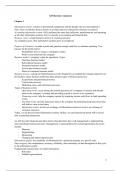Samenvatting
Samenvatting Accounting Information Systems boek en artikelen
- Instelling
- Radboud Universiteit Nijmegen (RU)
Samenvatting van het boek en de artikelen voor Accounting Information Systems op de Radboud Universiteit. Master Accounting and Control van Economics. Vakcode is MAN-MEC040. Leerjaar . Samenvatting in het Engels. Begrippen en onderzoekers schuingedrukt. Samenvatting van het boek Savage, A., Brannoc...
[Meer zien]




